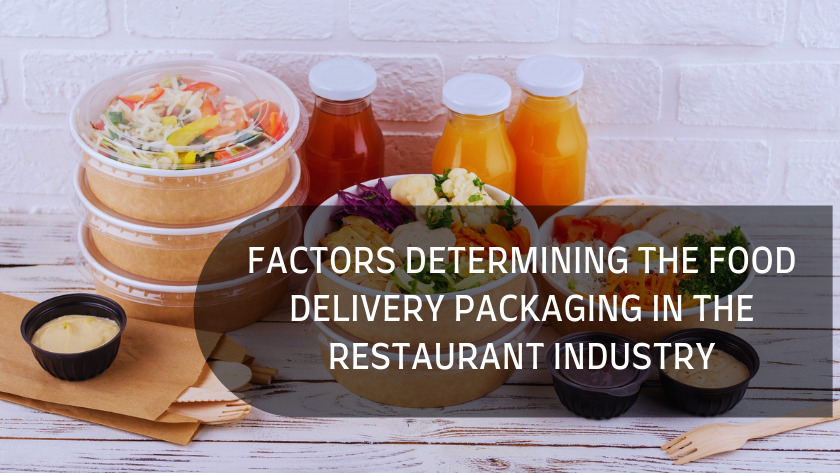A well-designed package can effectively communicate how your company operates.
The restaurant industry’s food packaging is unique in that it must keep the contents fresh and safe for consumption even after extended hours of travel and distribution. As a result, certain products will require their own packing materials to protect them from temperature, handling, and other factors. Depending on perishability, freshness, food type, and other factors, different food items require different packaging styles. In addition, it is critical to select a packing material that will tolerate contamination.

Restaurants should pack in a way that reflects their brand image. Restaurants must ensure that the packaging they choose is appealing to the intended demographic. Your package shouldn’t stray too far from commonly accepted norms, but it should stand out from the crowd. A well-designed package can effectively communicate how your company operates. Take, for example, NANTUCKET NECTARS, a well-known juice firm with a nationwide reach. Instead of using plastic bottles, they chose to package the juice in glass bottles. In comparison to the competition, this elevates the beverage to a higher level of quality. Your brand image is determined by how your package represents the audience. Your brand’s visibility is decided by the packaging style. When it comes to food distribution, there are a number of special factors that necessitate meticulous planning in order to avoid damaged items reaching end-consumers.
According to studies, the food business will rise by 150 million by the end of 2021. Packages are necessary for keeping and protecting products so that the quality of the content does not deteriorate before it reaches the consumers. When the food is delivered to the customers, the packages are discarded once the items are devoured. If the materials are not recyclable or biodegradable, they will be hazardous to the environment. As a result, adequate measures were required to ensure the environment’s long-term viability.
The restaurant sector has grown in response to the public’s demand for environmentally friendly products and packaging. The restaurant business is changing to compostable packaging that has a minimal environmental impact as a result of a growing trend and consumer preferences. Let’s look at the aspects that determine the packaging of food delivered to restaurants:
- The choice of materials and cost
- Safety concerns
- Trends
- Brand personality
- Regulatory policies
- Growing awareness
The choice of materials and cost
Choosing the proper materials is the first step in picking the right restaurant food packaging. Plastic, cardboard, Styrofoam, bamboo, paper, as well as biodegradable and ecological alternatives, are all options. Each has its own set of advantages and disadvantages.
Styrofoam is one of the best insulators for controlling hot and cold temperatures. It is both costly and harmful to the environment.
Plastics are durable and provide excellent food protection. Plastics, on the other hand, absorb moisture well, resulting in soggy dishes and possibly harming the environment.
Aluminum/foil has the benefits of being long-lasting, sealable, and non-absorbent. It also retains heat effectively and is ideal for foods such as sandwiches. The material is not microwavable and is therefore pricey.
When folded correctly, paper/cardboard is biodegradable, cost-effective, easy to modify, and strong. Many pizza delivery establishments utilize sturdy cardboard boxes to provide heat insulation and temperature control. The box contains small apertures on the side that allow some air to escape and shut tightly to decrease the amount of heat generated. This keeps the pizza from getting soggy by preventing condensation.
Alternatives to plastic packagings, such as sugarcane and bioplastics, are often more expensive but are significantly better for the environment. For example, KORE KITCHEN, a Los Angeles-based meal delivery service, employs recyclable glass bottles and biodegradable bagasse containers for its smoothies (a byproduct that remains after sugarcane processing).
Safety concerns
Choosing the correct restaurant food packaging also entails thinking about food safety and hygiene. Because the effect of COVID is still present in restaurants, food safety should be considered the most important factor. Restaurants may be tempted to utilize the same packaging as before the outbreak. You won’t be able to please your clients with higher-quality food delivery services, and you’ll need to make changes because food safety must be prioritized. Many restaurants and cafes, for example, have banned reusable bags and mugs due to cleanliness concerns.
Even if the risk of transmission is negligible, customers are more concerned about food safety. 70% of customers are more concerned about food safety now than they were before the outbreak. More than half of consumers use a disinfectant to clean their food packaging. Even if the adjustments you make are only temporary, putting extra precautions and safety measures on food packages can help customers relax by demonstrating that you are concerned about food safety.
Trends
Various trends that emerge and acquire prominence have an impact on food packaging in the restaurant business. For example, in the food and beverage industry, eco-friendly packaging is gaining a lot of traction. With cutting-edge design, this is one of the best techniques for staying in the market. It’s critical to remain on top of changing trends and adapt to new packaging designs. You must strike a balance between being innovative and being comfortable.
Brand personality
Food packaging, like food product packaging, must mirror the brand image of the restaurant that is delivering it. You must ensure that the design you select appeals to your intended audience. As previously stated, your packaging design should not break from internationally accepted criteria, but it should set your company apart from the competition. Your brand’s packaging can communicate how sophisticated or simple it is. Take, for example, NANTUCKET NECTARS, a well-known juice firm with a nationwide reach. Instead of using plastic bottles, the company chose to supply the juice in glass bottles. However, the drink appears to be a delightful thirst-quencher on a hot day due to the condensation that forms on the glass bottles. Small elements like this, when combined with others, contribute to the overall display of a brand’s personality in the packaging design.
Regulatory policies
Apart from prominent global restaurant companies’ initiatives for inventing and producing sustainable packaging materials, governments, and non-governmental groups are also contributing. Several governments have already created or implemented strong regulatory requirements for more environmentally friendly packaging. This is meant to encourage the packaging industry to switch to more sustainable packaging.
Growing awareness
One of the most exciting changes is that consumers are becoming more aware of the short- and long-term advantages of sustainable packaging. Indeed, many eateries tout sustainable and compostable packaging as a selling point. Fortunately, an increasing number of consumers are choosing eco-friendly packaging. This will undoubtedly offset the larger initial expenditure and make sustainable packaging viable for enterprises.
The food and restaurant industry offers a lot of opportunities for immersion. Restaurants must ensure that their strategies, technologies, and trends are in line with the wants and expectations of their customers. In today’s highly competitive world, a company that takes a customer-centric approach to meal delivery can succeed. Customers will be more satisfied as the food and delivery company expands.
Customers can order whatever they want from an online food delivery service. Restaurants should be more creative when it comes to providing trendy food packaging to their customers. Because the food industry is undergoing rapid innovation, growth, and innovation, it will become one of the most important sectors in the world. Keeping in mind the above-described variables and the current trends in the food delivery packaging sector can grab the attention of the target audience and have a positive impact on the business.


